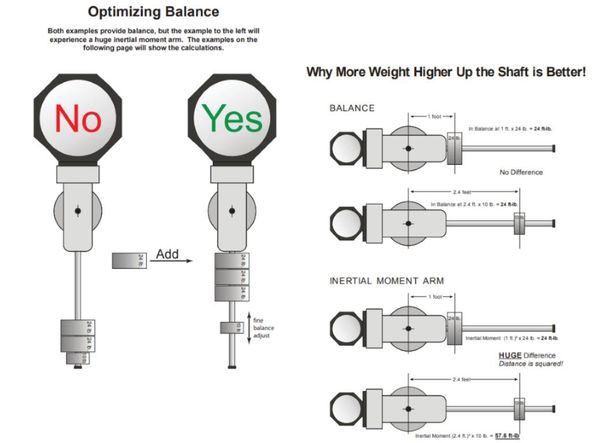Has anyone seen this or use this procedure?
Mar 20, 2020 18:11:23 #
I ran across this in a group I belong to and the math makes sense. Just wondering if anyone else balances their scopes this way.
Mar 20, 2020 18:17:27 #
Albuqshutterbug wrote:
I ran across this in a group I belong to and the math makes sense. Just wondering if anyone else balances their scopes this way.
Every time I've seen a counterweight in use, it has been at the far end of the opposing shaft. Closer in the weight would not balance.
Mar 20, 2020 23:11:06 #
I’ve always tried to keep the counterweights the same distance away as the OTA. For me that’s maybe half way down the bar. I would use more counterweight rather than moving weights further out.
Mar 21, 2020 04:14:21 #
I've never had to worry about it.
Even now, my equipment from the clamp up is minuscule compared to my mounts capacity.
15 Lbs. 6 Oz. of gear, on a 50 pound photographic rated mount.
In the interest of your post, I measured where my 11 pound counterweight is to the center axis of the Dec.
10.5" (center of the Dec to the bottom of the CW)
Then from the center of the Dec to the telescope load. 10.5" to the top of the telescope.
So the counter weight, and the telescope load it is counter balancing, are probably very equal distanced from the axis.
Many seem to subscribe to having the weight high on the bar.
I do not agree with the "Inertia" reasoning. Our mounts don't move that fast.
I have none of those worries in my new mount. Also, it has a soft start, and a soft stop, in the Gemini controller. Nice in that it ramps up the currant and speed, and ramps down the currant and speed.
But I've never needed much weight anyway.
In fact, my AVX needed me to make my own weights because the design was so poor the stock 11 pound CW could hit the elevation screw. That caused all sorts of heck, moving the screw was one, causing the clutches to slip and ruining the alignment was another.
So I made my own by casting lead in tin cans to mount on the shaft. Amounted to ~9 pounds, but most importantly they cleared everything properly.
Some folks tend to over think things. And they cause you worries you don't really need.
Inertia is when a turd hits the water, and when the hole in the water closes, it causes a jet of cold water to rise and hit your bottom.
And you can tell your friends, Sonny said so.
Even now, my equipment from the clamp up is minuscule compared to my mounts capacity.
15 Lbs. 6 Oz. of gear, on a 50 pound photographic rated mount.
In the interest of your post, I measured where my 11 pound counterweight is to the center axis of the Dec.
10.5" (center of the Dec to the bottom of the CW)
Then from the center of the Dec to the telescope load. 10.5" to the top of the telescope.
So the counter weight, and the telescope load it is counter balancing, are probably very equal distanced from the axis.
Many seem to subscribe to having the weight high on the bar.
I do not agree with the "Inertia" reasoning. Our mounts don't move that fast.
I have none of those worries in my new mount. Also, it has a soft start, and a soft stop, in the Gemini controller. Nice in that it ramps up the currant and speed, and ramps down the currant and speed.
But I've never needed much weight anyway.
In fact, my AVX needed me to make my own weights because the design was so poor the stock 11 pound CW could hit the elevation screw. That caused all sorts of heck, moving the screw was one, causing the clutches to slip and ruining the alignment was another.
So I made my own by casting lead in tin cans to mount on the shaft. Amounted to ~9 pounds, but most importantly they cleared everything properly.
Some folks tend to over think things. And they cause you worries you don't really need.
Inertia is when a turd hits the water, and when the hole in the water closes, it causes a jet of cold water to rise and hit your bottom.

And you can tell your friends, Sonny said so.
Mar 21, 2020 12:33:49 #
Albuqshutterbug wrote:
I ran across this in a group I belong to and the math makes sense. Just wondering if anyone else balances their scopes this way.
I admit to knowing very little about how to set up a telescope, but I don't understand why a high moment of inertia is not a good thing in this application.
Mar 21, 2020 14:47:27 #
Albuqshutterbug wrote:
I ran across this in a group I belong to and the math makes sense. Just wondering if anyone else balances their scopes this way.
Considering the very low rotational speed of an EQ mount I doubt inertia is all that important!?
However, it is important to keep the balance slightly in favor of keeping the gears meshed (and not floating), i.e.: a touch out of balance to keep the gears lifting the load.
bwa
Mar 21, 2020 15:45:11 #
tony85629
Loc: Sahuarita, Az
Roland, the Astro-Physics guru advises to place the counterweights as close to the mount as possible.
If you want to reply, then register here. Registration is free and your account is created instantly, so you can post right away.



